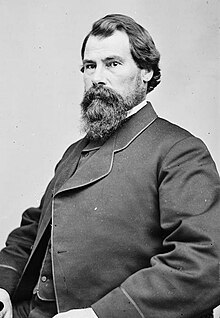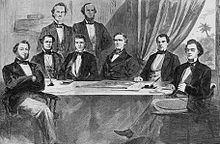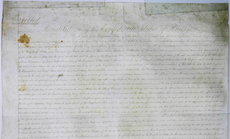
John H. Reagan

John H. Reagan | |
|---|---|
 | |
| United States Senator from Texas | |
| In office March 4, 1887 – June 10, 1891 | |
| Preceded by | Samuel Maxey |
| Succeeded by | Horace Chilton |
| Railroad Commissioner of Texas | |
| In office June 10, 1891 – January 20, 1903[1] | |
| Governor | Jim Hogg Charles A. Culberson Joseph D. Sayers |
| Preceded by | Office established |
| Succeeded by | Oscar Branch Colquitt |
| Confederate States Secretary of the Treasury | |
| Acting April 27, 1865 – May 10, 1865 | |
| President | Jefferson Davis |
| Preceded by | George Trenholm |
| Succeeded by | Position abolished |
| Confederate States Postmaster General | |
| In office March 6, 1861 – May 10, 1865 | |
| President | Jefferson Davis |
| Preceded by | Position established |
| Succeeded by | Position abolished |
| Member of the U.S. House of Representatives from Texas | |
| In office March 4, 1875 – March 3, 1887 | |
| Preceded by | William Herndon |
| Succeeded by | William Martin |
| Constituency | 1st district (1875–83) 2nd district (1883–87) |
| In office March 4, 1857 – March 3, 1861 | |
| Preceded by | Lemuel Evans |
| Succeeded by | George Whitmore |
| Constituency | 1st district |
| Member of the Texas House of Representatives from the Nacogdoches district | |
| In office December 13, 1847 – November 5, 1849 | |
| Personal details | |
| Born | October 8, 1818 Gatlinburg, Tennessee, U.S. |
| Died | March 6, 1905 (aged 86) Palestine, Texas, U.S. |
| Resting place | Palestine City Cemetery Palestine, Texas |
| Political party | Democratic |
| Spouse(s) |
Martha Music
(m. 1844; died 1845)Edwina Moss Nelms
(m. 1852; died 1863)Molly Ford Taylor (m. 1866) |
John Henninger Reagan (October 8, 1818 – March 6, 1905) was an American politician from Texas. A Democrat, Reagan resigned from the U.S. House of Representatives when Texas declared secession from the United States and joined the Confederate States of America. He served in the cabinet of Jefferson Davis as Postmaster General.

After the Confederate defeat and his release from prison after the war, Reagan called for cooperation by the southern states with the U.S. government, an unpopular position among most conservative whites. He was elected to Congress in 1874[3][4] and was elected in 1886 by the state legislature as a Democrat from Texas to the U.S. Senate, where he served one term from 1887 to 1891. He resigned from the seat when appointed by the governor as chairman of the Texas Railroad Commission. He was among the founders of the Texas State Historical Association.

He was the only former Confederate cabinet member to be sat in the US Senate after the civil war. Alexander H. Stephens, the only Confederate vice president, was also elected in 1866 to represent Georgia, but was refused to be seated to the Senate due to his war history. Elected as the representative of the Democratic Party for the state of Texas, he sat in the Senate for just one term; he was one of just three former Confederate cabinet members to take major political offices after the war.

Early life

John Henninger Reagan was born in 1818 in Gatlinburg, Tennessee, to Timothy Richard and Elizabeth (Lusk) Reagan. His parents were primarily of Irish, English and Scottish descent; his middle name was for his Irish ancestors.

He left Tennessee at age nineteen and traveled to the Republic of Texas, which had become independent from Mexico the year before in 1836. Reagan worked as a surveyor from 1839 to 1843. He bought a property and farmed in Kaufman County until 1851. During the time he worked as a surveyor, he also served as a private tutor to the children of John Marie Durst.[5]

Reagan read the law, served as an apprentice in an established firm, and was licensed to practice in 1846. He opened an office in Buffalo and the same year was elected a probate judge in Henderson County. In 1847 he was elected to the Texas House of Representatives but was defeated for a second term in 1849. He was admitted to the bar in 1848 and practiced in both Buffalo and Palestine, Texas.[3]

Reagan was elected as a district judge in Palestine, serving from 1852 to 1857. His efforts to defeat the American Party (Know-Nothings) resulted in his election to Congress as a Democrat in 1857 from Texas's 1st congressional district.

Reagan was a staunch supporter of slavery. He believed abolition would cause such social problems as to require Southern whites "exterminate the greater portion of the [black] race."[6] He also believed in the federal protections of slavery under the U.S. Constitution as extensions of private property rights, therefore he supported the United States. But when it became clear that Texas would secede, Reagan resigned from Congress on January 15, 1861, and returned home to the state to participate in the rebellion.[4]

He participated in the secession convention at Austin, Texas on January 31, 1861. Chosen as a member of the Provisional Confederate Congress, President Jefferson Davis appointed Reagan to his cabinet as Postmaster General within a month.

Civil War

Despite the hostilities, the United States Post Office Department continued operations in the Confederacy until June 1, 1861, when the Confederate service took over its functions.[7]

Reagan sent an agent to Washington, D.C., with letters asking the heads of the United States Post Office Department's various bureaus to work for him. Nearly all did so and brought copies of their records, contracts, account books, etc. "Reagan in effect had stolen the U.S. Post Office," historian William C. Davis later wrote.[citation needed]

Reagan cut expenses by eliminating costly and little-used routes and forcing railroads that carried the mail to reduce their rates. Despite the problems the war caused, his department managed to turn a profit, "the only post office department in American history to pay its own way," wrote William C. Davis.[citation needed] Reagan was the only member of the cabinet to oppose Robert E. Lee's offensive into Pennsylvania in June–July 1863. He instead supported a proposal to detach the First Corps of the Army of Northern Virginia to reinforce Joseph E. Johnston in Mississippi, to break the Siege of Vicksburg. Historian Shelby Foote noted that, as the only Cabinet member from west of the Mississippi, Reagan was acutely aware of the critical consequences of Vicksburg's capture and control of the river by U.S. forces.

When Davis abandoned Richmond, Virginia on April 2, 1865, shortly before the entry of Army of the Potomac under George G. Meade, Reagan accompanied the president on his flight to the Carolinas. On April 27, Davis made him Secretary of the Treasury after George A. Trenholm's resignation. Reagan served in that capacity until he, Davis, and Texas governor Francis R. Lubbock were captured near Irwinville, Georgia, on May 10.[4]

Reagan was imprisoned with Confederate vice president Alexander Stephens at Fort Warren in Boston, Massachusetts. He was held in solitary confinement for twenty-two weeks. On August 11, he wrote an open letter to his fellow Texans urging cooperation with the United States, renunciation of the secession convention, the abolition of slavery, and letting formerly enslaved people vote. He warned that the U.S. government would be forced to impose military rule to enforce these measures if Texans did not voluntarily adopt them. Abolition was underway, and Reagan knew there was support for granting the vote to freedmen. Texans denounced him. After being released from prison later that year, he returned to his home in Palestine in December.[4]

Return to public life


To those who felt that the Reconstruction was unduly harsh, Reagan's prescience was hailed—he became known as the "Old Roman," a Texas Cincinnatus. He was part of the successful effort to remove Republican Edmund J. Davis from the governorship in 1874 after Davis attempted to remain in office illegally after losing the election.

That year Reagan was elected to the Congressional seat he held before the war, and he served from March 4, 1875, to March 3, 1887. In 1875, he was a delegate to the convention that wrote a new state constitution for Texas. In Congress, he advocated federal regulation of railroads and helped create the Interstate Commerce Commission. He also served as the first chairman of the Committee on Post Offices and Post Roads.

Elected by the Texas State Legislature to the U.S. Senate in 1887 (serving March 4, 1887, to June 10, 1891), Reagan resigned to become chair of the Railroad Commission of Texas at the behest of his friend, Governor Jim Hogg. He chaired it until 1903, continuing to serve under governors Charles A. Culberson and Joseph D. Sayers. Hogg had run on a platform of state regulation of railroads.[4][3]


Conscious of the importance of recounting and interpreting history, Reagan founded the Texas State Historical Association. He also attended reunions of Confederate veterans in his state. He wrote his Memoirs, With Special Reference to Secession and the Civil War, published in 1905. Later that year, Reagan died of pneumonia at his home in Palestine, the last surviving member of Jefferson Davis' cabinet in the Confederate government. Reagan was buried in East Hill Cemetery in Palestine, Texas.[4]

Legacy and honors
- Historian Ben H. Procter included Reagan in his list of the "four greatest Texans of the 19th century," along with Stephen F. Austin, Sam Houston, and James Stephen Hogg.
- Reagan County, Texas, was named in his honor.[4]
- Several schools were named for him, including John H. Reagan Elementary School in Dallas and a Reagan High School in Houston and Austin. Reagan High School in Houston was renamed in 2016 to Heights High School by the Houston Independent School District.[8] In 2019, Reagan Early College High School in Austin was renamed as Northeast Early College High School.[9]
- The John H. Reagan State Office Building on the Texas State Capitol grounds was named in his honor.
- Reagan was commemorated by a statue on the University of Texas at Austin campus. On August 21, 2017, Reagan's statue in Austin was removed.[10] Plans were announced to add it to the Dolph Briscoe Center for American History.[11]
- A park in his hometown of Palestine, Texas, was named for him. A statue of Reagan was installed on the grounds.[11]
See also
References
- ^ "Railroad Commissioners Past through Present". www.rrc.texas.gov. Retrieved August 7, 2024.
- ^ Procter, Ben H. (July 6, 2021). "Reagan, John Henninger (1818–1905)". Texas State Historical Association. Retrieved August 7, 2024.
- ^ a b c "REAGAN, John Henninger, (1818 - 1905)". Biographical Directory of the United States Congress. Retrieved November 27, 2010.
- ^ a b c d e f g "REAGAN, JOHN HENNINGER". Texas State Historical Association. Retrieved November 27, 2010.
- ^ Raines, Cadwell Walton (1902). Year book for Texas. Gammel Book Company.
- ^ "A Century of Lawmaking for a New Nation: U.S. Congressional Documents and Debates, 1774 - 1875". memory.loc.gov. Retrieved December 21, 2017.
- ^ Boyd B. Stutler (1962). "The Confederate Postal Service in West Virginia". West Virginia Archives and History. Retrieved November 19, 2010.
- ^ "HISD approves name changes for seven schools". ABC 13. May 12, 2016. Retrieved May 12, 2017.
- ^ AUSTIN'S JOHN REAGAN HIGH SCHOOL DECIDES ON NEW NAME[permanent dead link]
- ^ Bromwich, Jonah Engel (August 21, 2017). "University of Texas at Austin Removes Confederate Statues in Overnight Operation". The New York Times. ISSN 0362-4331. Retrieved April 22, 2024.
- ^ a b "Confederate Statues on Campus" (PDF). Archived from the original (PDF) on August 21, 2017. Retrieved August 23, 2017.
Further reading
- Anderson, John Nathan. "Money or Nothing: Confederate Postal System Collapse during the Civil War," American Journalism, 30 (Winter 2013), 65–86.
- Branner, Peter A. The Organization of the Confederate Postoffice Department at Montgomery. Montgomery, Alabama: The Author, 1960.
- Dietz, August. Confederate States Post-office Department. Richmond, Virginia: Dietz Press, 1962.
- Dietz, August. The Postal Service of the Confederate States of America. Richmond, Virginia: Dietz Printing, 1929.
- Garrison, L. R. “Administrative Problems of the Confederate Post Office Department, I.” Southwestern Historical Quarterly 18#2 (1915), pp. 111–141 online
- Garrison, L. R. “Administrative Problems of the Confederate Post Office Department, II.” Southwestern Historical Quarterly 19#3 (1916), pp. 232–250. online
- McCaleb, Walter Flavius. "The Organization of the Post-Office Department of the Confederacy." American Historical Review 12#1 (1906), pp. 66–74. online
- Ben H. Procter. Not Without Honor. Austin: University of Texas Press, 1962.
- Reagan, John Henninger. Memoirs, With Special Reference to Secession and the Civil War. New York: Neale, 1905.
- Wirenga, Theron, editor. Official Documents of the Post-office Department of the Confederate States of America. Holland, Michigan: The Editor, 1979. Two volumes.
- United States Congress. "John H. Reagan (id: R000098)". Biographical Directory of the United States Congress. Retrieved on 2009-03-19
External links
 Media related to John Henninger Reagan at Wikimedia Commons
Media related to John Henninger Reagan at Wikimedia Commons- John Henninger Reagan from the Handbook of Texas Online
- John H. Reagan lineage — Smokykin.com
- 1818 births
- 1905 deaths
- Methodists from Texas
- American people in rail transportation
- Executive members of the Cabinet of the Confederate States of America
- Confederate States Department of the Treasury officials
- Democratic Party members of the United States House of Representatives from Texas
- Democratic Party United States senators from Texas
- Deputies and delegates to the Provisional Congress of the Confederate States
- Democratic Party members of the Texas House of Representatives
- People from Kaufman County, Texas
- People from Palestine, Texas
- People from Sevier County, Tennessee
- People of Texas in the American Civil War
- Signers of the Confederate States Constitution
- Signers of the Provisional Constitution of the Confederate States
- Texas lawyers
- Presidents of the Texas State Historical Association
- Members of the Railroad Commission of Texas
- 19th-century United States senators
- 19th-century members of the United States House of Representatives
- 19th-century members of the Texas Legislature
See what we do next...
OR
By submitting your email or phone number, you're giving mschf permission to send you email and/or recurring marketing texts. Data rates may apply. Text stop to cancel, help for help.
Success: You're subscribed now !





